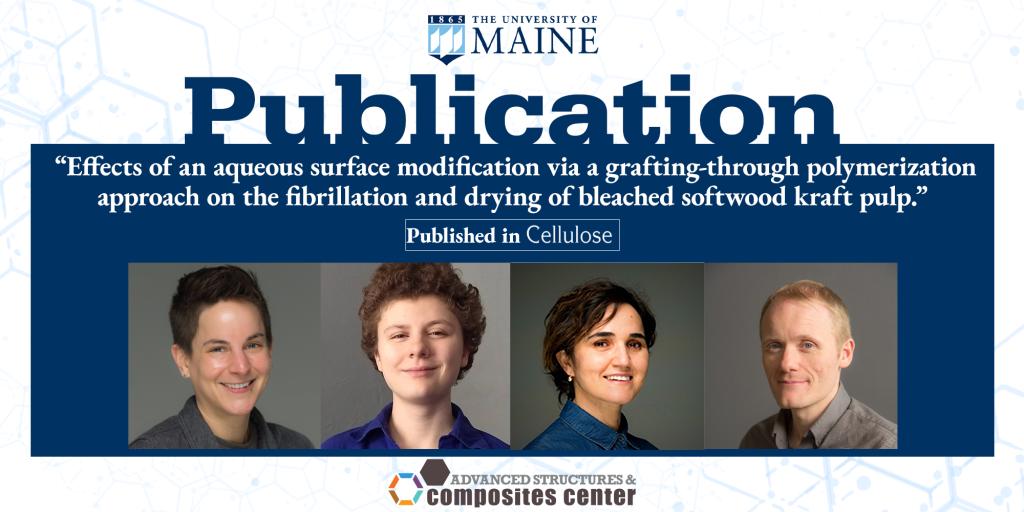
Article by Christau, Alyamac-Seydibeyoglu, Thayer, and Gramlich on surface modifications to bleached softwood kraft pulp published in Cellulose
Orono, Maine — An article by ASCC researchers Stephanie Christau, Elif Alyamac-Seydibeyoglu, Kayla Thayer, and William Gramlich was published in Cellulose. The paper is titled “Effects of an aqueous surface modification via a grafting-through polymerization approach on the fibrillation and drying of bleached softwood kraft pulp.”
Cellulose nanofibrils, a component of wood pulp used in papermaking, packaging, and composite materials, has become a popular research subject. Cellulose nanofibril production requires high energy for fibrillation, the process of forming fibrils. Therefore, researchers have developed several methods for pretreating wood pulp to reduce the energy required for fibrillation. Some of these methods provide specific surface modifications of the resulting cellulose nanofibrils and control resulting nanofibril morphology.
ASCC researchers used a fully aqueous grafting-through polymerization as a chemical pretreatment method to functionalize the surface of bleached softwood kraft pulp fibers prior to fibrillation. Five different polymeric surface modifications were applied to bleached softwood kraft pulp. The researchers investigated the effects of the polymeric surface modifications on fibrillation and on the drying-induced aggregation of bleached softwood kraft pulp. Optical fiber length analysis and SEM image analysis were used to study the fibrillated samples. The researchers found that all surface modifications decreased the water retention value of the bleached softwood kraft pulp after fibrillation, but there were no significant differences between the polymers. Polymeric surface modifications affected the morphology of the fibrillated samples after drying and grinding, indicating that the polymer coating could be used to target specific behavior as desired.
The simple nature of this process–using water as the solvent—combined with the scalability and versatility of the process, leads the researchers to believe that this could be a viable option for the pretreatment of lignocellulosic feedstock with industrial relevance.
Effects of an aqueous surface modification via a grafting-through polymerization approach on the fibrillation and drying of bleached softwood kraft pulp
Authors: Stephanie Christau, Elif Alyamac-Seydibeyoglu, Kayla Thayer & William Gramlich
Cellulose (2022)
Full Article
Received: 22 June 2022 / Accepted: 05 November 2022 / Published: 17 November 2022
Abstract
A simple, fully aqueous grafting-through polymerization approach was employed to apply various polymeric surface modifications to bleached softwood kraft pulp (BSKP). Poly(acrylamide), poly(acrylic acid), poly(oligo(ethylene glycol) methyl ether methacrylate), poly(methyl methacrylate), and poly(dimethyl itaconate) were chemically attached to the BSKP fiber surface, as confirmed by Fourier transform infrared spectroscopy. The modified and unmodified BSKP samples were fibrillated and evaluated using optical fiber length analysis and scanning electron microscopy analysis. Furthermore, the effect of the polymeric surface modifications before and after fibrillation on the filtration water retention value (WRVfiltration) was studied. While the polymeric surface modifications had little effect on the percentage of fines and width distribution of nanosized fibrils, they significantly reduced the WRVfiltration after fibrillation. The polymeric surface modifications were also found to affect the morphology after drying and grinding.
Keywords: Bleached softwood kraft pulp, Cellulose nanofibrils, Grafting-through polymerization, Fibrillation
Article by Christau, Alyamac-Seydibeyoglu, Thayer, and Gramlich on surface modifications to bleached softwood kraft pulp published in Cellulose
Contact: Katelin Moody, katelin.moody@maine.edu
